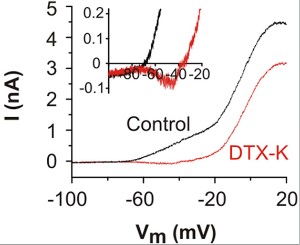Overview
Cat #:
D-400
Alternative Name Venom basic protease inhibitor K, DTX-K
Lyophilized Powder yes
Origin Natural peptide isolated from Dendroaspis polylepis polylepis (Black mamba).
MW: 6560 Da
Purity: >99% (HPLC)
Effective concentration 100 nM
Sequence AAKYCKLPLRIGPCKRKIPSFYYKWKAKQCLPFDYSGCGGNANRFKTIEECRRTCVG-OH
Modifications Disulfide bonds between Cys5-Cys55, Cys14-Cys38, and Cys30-Cys51.
Molecular formula C294H462N84O75S6.
CAS No.: 119128-61-9
Activity Dendrotoxin-K is a highly selective and potent blocker of voltage-gated K+ channels KV1.1 and Kv1.1-containing heterooligomer.
Accession number P00981
Shipping and storage Shipped at room temperature. Product as supplied can be stored intact at room temperature for several weeks. For longer periods, it should be stored at -20°C.
Solubility Any aqueous buffer (pH 7.5). Centrifuge all product preparations before use (10000 x g 5 min).
Storage of solutions One week at 4°C or six months at -20°C.
Our bioassay
 Alomone Labs Dendrotoxin-K inhibits KV1.1 channel currents heterologously expressed in Xenopus oocytes.A. Time course at plateau of Dendrotoxin-K (#D-400) action on KV1.1 currents. Current amplitude at plateau was plotted as a function of time. Membrane potential was held at -80 mV and oocytes were stimulated by a 100 ms voltage ramp to -10 mV. 1 nM Dendrotoxin-K (applied for 2 min, green) were perfused during the period marked by the bar, (as indicated) and showed 70-80% inhibition of control current. B. Superimposed traces of channel current in the absence (black) and presence (green) of 1 nM Dendrotoxin-K (taken from experiment in A).
Alomone Labs Dendrotoxin-K inhibits KV1.1 channel currents heterologously expressed in Xenopus oocytes.A. Time course at plateau of Dendrotoxin-K (#D-400) action on KV1.1 currents. Current amplitude at plateau was plotted as a function of time. Membrane potential was held at -80 mV and oocytes were stimulated by a 100 ms voltage ramp to -10 mV. 1 nM Dendrotoxin-K (applied for 2 min, green) were perfused during the period marked by the bar, (as indicated) and showed 70-80% inhibition of control current. B. Superimposed traces of channel current in the absence (black) and presence (green) of 1 nM Dendrotoxin-K (taken from experiment in A).
References - Scientific background
- Schweitz, H. et al. (1990) Toxicon 28, 847.
- Wang, F.C. et al. (1999) Eur. J. Biochem. 263, 222.
- Owen, D.G. et al. (1997) Br. J. Pharmacol. 120, 1029.
- Southan, A.P. and Robertson, B. (1998) Br. J. Pharmacol. 125, 1375.
Scientific background Dendrotoxin-K is isolated from Dendroaspis p.polylepis snake venom by modification of the procedure of Schweitz1 and purified to homogeneity. It blocks mainly KV1.1 (EC50=0.6 nM2) and Kv1.1-containing heterooligomer.
Target KV1.1, Kv1.1-containing heterooligomer.
Peptide Content: 100%
Lyophilized Powder
Dendrotoxin-K (#D-400) is a highly pure, natural, and biologically active peptide toxin.
Image & Title 
Alomone Labs Dendrotoxin-K blocks LVA K+ currents in cultured mouse SGNs.Whole-cell voltage clamp recordings on mouse spiral ganglion neurons (SGNs). Current response during a voltage ramp (between -143 mV and +47 mV, duration 400 ms) before (control) and after bath application of 100 nM Dendrotoxin-K (#D-400). Dendrotoxin-K (DTX-K) blocks the low voltage activated (LVA) K+ current, revealing a small inward current activated at potentials positive to -65 mV (inset).Adapted from Browne, L. et al. (2017) eNeuro 4, e0303. with permission of the Society for Neuroscience.

Alomone Labs Dendrotoxin-K blocks LVA K+ currents in cultured mouse SGNs.Whole-cell voltage clamp recordings on mouse spiral ganglion neurons (SGNs). Current response during a voltage ramp (between -143 mV and +47 mV, duration 400 ms) before (control) and after bath application of 100 nM Dendrotoxin-K (#D-400). Dendrotoxin-K (DTX-K) blocks the low voltage activated (LVA) K+ current, revealing a small inward current activated at potentials positive to -65 mV (inset).Adapted from Browne, L. et al. (2017) eNeuro 4, e0303. with permission of the Society for Neuroscience.
For research purposes only, not for human use
Last Update: 07/05/2024
Applications
Citations
Citations
Product citations
- Browne, L. et al. (2017) eNeuro 4, e0303.
- Vivekananda, U. et al. (2017) Proc. Natl. Acad. Sci. U.S.A. 114, 2395.
- Begum, R. et al. (2016) Nat. Commun. 7, 12102.
- Fellerhoff-Losch, B. et al. (2015) J. Neural Transm. 123, 137.
- Glasscock, E. et al. (2015) Basic Res. Cardiol. 110, 47.
- Murray, J.K. et al. (2015) J. Med. Chem. 58, 6784.
- Smith, K.E. et al. (2015) J. Neurosci. 35, 11221.
- Lee, K.Y. and Chung, H.J. (2014) Neuroscience 277, 610.
- Tabarean, I.V. (2014) PLoS ONE 9, e96643.
- Jeon, W.I. et al. (2012) Anticancer Res. 32, 5279.
- Baker, M.D. et al. (2011) Mol. Cell. Neurosci. 48, 258.
- Wang, T. et al. (2012) PLoS ONE 7, e43950.
- Fulton S. et al. (2011) J. Biol. Chem. 286, 9360.
- Li, K.X. et al. (2011) Nat. Neurosci. 15, 267.
- Martel, P. et al. (2011) PLoS ONE 6, e20402.
- Hsiao, C.F. et al. (2009) J. Neurophysiol. 101, 1407.
- Madrid, R. et al. (2009) J. Neurosci. 29, 3120.
- Yang, Q. et al. (2007) Neuroscience 149, 315.
- Guan, D. et al. (2006) J. Physiol. 571, 371.
- Speake, T. et al. (2004) Am. J. Physiol. 286, C611.
- Mo, Z.L. et al. (2002) J. Physiol. 542, 763.
- Zagorodnyuk, V.P. et al. (2002) Br. J. Pharmacol. 137, 1195.

